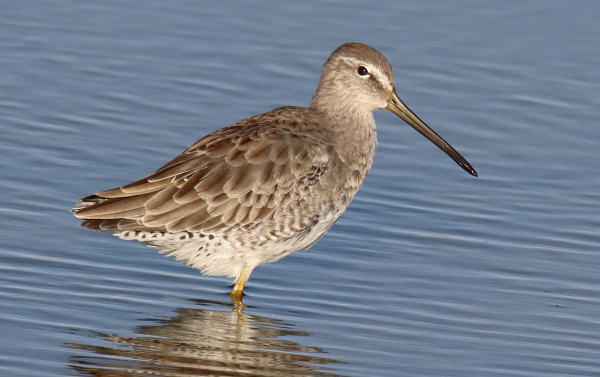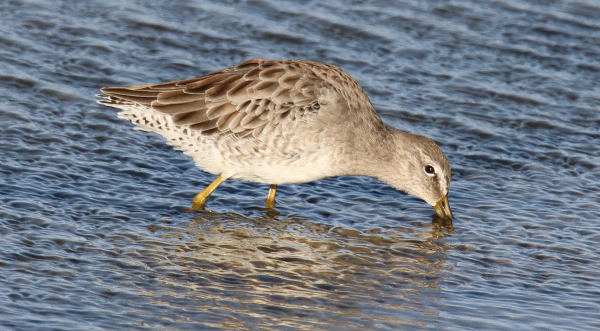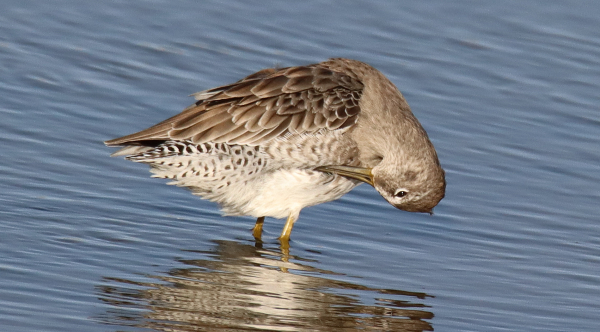It’s that time of the year when many birds have new basic plumage, what we often refer to as “winter plumage,” but either way it tends to be less colorful, less spectacular than their alternate “breeding plumage.” At first it may be a little disappointing to see the duller, tanner or grayer plumage that replaces the colorful feathers of the nesting period. But when you get a good look at the fresh new feathers that often show a lighter-colored trailing edge, you get a renewed appreciation for the form and activities of sandpipers and plovers of all sizes.

Even though it has been a poor fall in my area for shorebirds – sandpipers and plovers are collectively known as shorebirds; lately a few of the sandpipers I’ve seen have yielded nice photo opportunities, and they provided some basic scenes and activities that you will encounter when you are on a “shore” looking for birds to photograph. My surefire shorebird location has provided some interesting shorebirds, but only in small numbers – ones and twos, and sometimes threes rather than a flock. For example, I can’t remember the last time I found a single Long-billed Dowitcher. I’m used to seeing a half-dozen to 50 or more in a flock, but seeing a lone dowitcher is unusual.
This lone dowitcher was either tired or very trusting or both: When I encountered it, the Long-bill continued with its feeding probes into the mud a few inches below the water’s surface. Either way, it permitted me to get into position, relatively close, and while at first I expected to take a quick photo or 2, and move on, I must admit the bird captivated me. Viewed through the magnification of my camera lens, I began to appreciate its basic plumage and the subtle colors, and especially the delineation of individual feathers and varied markings on the tail and flanks. Its bill was an obvious feature, but when I noticed the position of its nostrils at the base of the bill, it was again informative (but not news).

I settled in with this Long-billed Dowitcher, hoping it might provide a variety of photo “poses” as it switched from probing to preening – after cleaning the light cover of mud from the lower third of its bill, it began reaching here and there, obscuring the end of its beak as it preened feathers and plumage areas, dipping its bill into the water periodically to clean it and to add a bit of fresh water to its preening action. That’s when I was on high alert for the bird to do a full-on wing flap as is the norm after a period of preening – but this lone sandpiper merely ruffled its body feathers and called it good – no spread wing action, alas.
That’s another thing that stood out about this photo session though: This bird provided subtle actions in concert with its subtle coloration, both of which I had a better appreciation for, during and after our time together. Sometimes subtle is good, and in this case it certainly provided some pleasing photos I wanted to share, with as much excitement as I have for some other images that include bird flights and even bird fights. Here’s a bird doing simple bird activities – feeding, caring, and resting – that’s plenty sometimes, and it’s more a part of everyday activities.

Basic Water, Timing, & Sunlight
Water tends to be a basic element in shorebird photography; sandpipers and plovers are most often observed either wading in shallow water, walking along the shore with water behind them, or in front of birds. Some species might enter deeper water where they swim, most notably phalaropes, but also avocets and, rarely, other species. The color of the water is helpful in ‘painting’ a colorful setting for the bird or birds, and of course, the color of the water is created by the reflection of the color of the sky above.
Water ‘quality’ also changes with its ‘texture’ in the form of ripples, waves, or a glassy smooth surface. When there is water directly between you and the bird, or adjacent to the bird, a mirror image often comes into play. This mirror image may be exact, in which it can be utilized as you compose your photos, which can be very impressive. But the mirror image can also be distracting at times, or it may be an indifferent element. You can reduce its affect by cropping most of it out of the photo during editing. Therefore, in addition to composing with the reflection in mind, you should also remember that you can re-compose and design an image using your photo editing software to crop areas, or not crop them from any image.

As for lighting, you will get the best, brightest, and most accurate colors of birds and their surroundings with sunlight provided 1 to 4 hours after sunrise and between 4 and 1 hour before sunset during prime summer hours. In that way lighting and timing is tightly connected. During these hours, the sun is at an angle between 30 and 60 degrees above the level horizon. Now, as summer turns to fall, the sun is already in a more southerly position during midday hours, which will improve during the next couple months to the point where we can photograph throughout the day because the sun is at that prime 30 to 60 degree level in the southern sky.

Photographed in mid-dunk while foraging in water too deep to wade in, it’s hard to identify the shorebird in this photo until it raises its head.
|
Another timing element that I always point out is that when it’s overcast – when the sunlight is not right I refrain from bird photography. In my experience it’s a waste of time to photograph during overcast weather because resulting photos lack quality, color, and detail. It’s also important to watch for sunlight periods by monitoring weather forecasts, especially when planning bird photography trips, near and far, because if there is no sunlight, any photographs taken will be strongly compromised.
Even with the best sunlight, positioning is paramount. A best-case situation is to position yourself between the sun and the bird or birds – with the sun at your back and the bird in front of you. Keep that in mind any time you are photographing, and a handy reminder is to use your shadow as a pointer: Check your shadow and position yourself so your shadow points at your subject. That’s so you utilize the best sunlight, and so you eliminate shadows on your subject. Of course, you may find yourself at one side of your subject from time to time, but do the best you can, and sometimes if you watch the sunlight highlighting the face of the bird as well as the body as it turns this way and that, you may find a good alternative position that provides good photos.

Phalarope Light
Case in point, last week when I found about a dozen Wilson’s Phalaropes in basic plumage feeding near the shore of a wetland, I did my best to get into direct position between birds and the late afternoon sun. I was positioned to the left of a direct angle, but I couldn’t enter the water without scaring the feeding sandpipers to utilize the best sunlight direction. However, I found that when the swimming phalaropes turned in my direction, the sunlight brightened their face and full body – bingo!
As with any birds we photograph, it’s important to try to get action photos in addition to species portraits, but ultimately, take the photos the birds provide, and spend a little time waiting to see what happens next. You don’t need to spend a bunch of time; just don’t leave prematurely. Give the bird a few more minutes, then make a judgement on whether to stay or leave. I always figure that if there is a trusting bird within photo range of your lens, in good sunlight, in a nice setting, you really have a best case scenario before you – make the most of it. And that’s a good adage to have in mind as we photograph throughout the fall season – make the most of it!
Article and photographs by Paul Konrad
Share your bird photos and birding experiences at editorstbw2@gmail.com